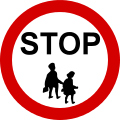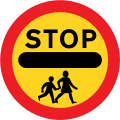Crossing guard
A crossing guard (United States, Canada and India), a school crossing patrol officer (United Kingdom), school crossing supervisor and sometimes guard (Australia) or school road patrol and guard (New Zealand) is a traffic management volunteer who is normally stationed on busy roadways to aid pedestrians. Often associated with elementary school children, crossing guards to stop the flow of traffic so pedestrians may cross an intersection. Crossing guards are known by a variety of names, the most widely used in the United Kingdom and Australia being "lollipop lady/man", a reference to the large signs used that resemble lollipops.
Australia and the United Kingdom

In Australia and the United Kingdom, a school crossing supervisor or school crossing patrol officer is commonly known as a lollipop man or lollipop lady, because of the modified circular stop sign he or she carries, which resembles a large lollipop.The term was coined in the 1960s when road safety awareness programs were rolled out in schools throughout the UK and the crossing patrols were introduced by the Road Traffic Regulation Act 1967.[1] Ventriloquist John Bouchier visited schools nationwide with his ventriloquist dummy to help make children more aware of road safety. During these visits John's main character, a young boy named Charlie, referred to crossing patrol officers as "Lollipop men" for the first time. The term became widely used very quickly and has crossed into popular culture, both in the folk world (the common morris-dance tune "The Lollipop Man" has lewd lyrics in one tradition), and in the pop world (see the song by the band Sweet).
Research in the UK has revealed that crossing guards ('lollipoppers') are seen as the safest school crossing option by parents and children, with nine out of ten (92 per cent) believing that every school should have a one.[2]
In Australia, school crossing supervisors are employed by state government transport authorities and are posted at crossing sites by government officers. The exceptions to this rule are Victoria, where local councils employ crossing supervisors through their local laws department, and Western Australia, where supervisors are known alternatively as Police Traffic Wardens, and are employed by the traffic management unit of the WA Police. Supervisors in WA use handheld neon stop-flags instead of the traditional lollipop.
Under UK law it is an offence for a motorist not to stop if signalled to do so by a patroller. In the past patrollers only had the authority to stop the traffic for children. However, the Transport Act 2000 changed the law so that a patroller had the authority to stop the traffic for any pedestrian.[3]
In the UK, the stop sign has the word "STOP", a strip of black, and an international symbol for children (the symbol is sometimes replaced with the written word "CHILDREN"). The patrollers are employed by local authorities, but there is a greater degree of standardisation of the system across the country than in the US. They are often older people who have retired from full-time employment. They may be based at a pelican crossing, a zebra crossing, or just an ordinary point on the road widely used as a crossing.
Following UK legislation in 2000 stating that lollipoppers were no longer a legal requirement for schools, an increasing number of crossing guards have been taken off the road. Due to an increase in abuse, threats and other aggressive behaviour from some drivers, signs with built-in hi-tech cameras are being introduced to record offenders, cars and registrations.
Austria
In Austria the crossing guards are called Schülerlotse. The service was initiated the first time in Salzburg in 1964. Most of the crossing guards are persons liable for compulsory community service (instead of military service), volunteers or officers of the local or federal police.
Germany

In Germany the crossing guards are called Verkehrshelfer, which means traffic assistant. Due to the increasing traffic the first service started in 1954. The traffic assistants are trained, organized and equipped by the German Traffic Watch Association (Deutsche Verkehrswacht) in cooperation with the state police. To become a traffic assistant, the candidate has to pass an exam with different regulations from state to state. Depending on the state, studends at the age of eleven already can became traffic cadet, the first rank of the hierarchical structure of the Verkehrshelfer.
The official name of Verkehrshelfer was chosen, because the previous denomination Schülerlotse is related to schools only, but the traffic assistants are deployed for major events like soccer games as well. Currently there are about 50.000 traffic assistants in Germany, all of them are volunteers. The crossing guards are equipped with reflective jackets or uniform-like reflective dresses and circular traffic signs.
Republic of Ireland
Some school crossings are operated by Junior Traffic Wardens, who are typically senior pupils at the school, working in teams of six.
Japan

Crossing guards in Japan are called Gakudōyōgoin (学童擁護員). The system started in Tokyo in 1959. It was founded as a way to offer employment to widows after World War II.
New Zealand
In New Zealand, a school crossing patrol, more commonly known as a School Patrol or Road Patrol, was first introduced in 1931 and has been acknowledged in New Zealand legislation since 1944. Students and supervising teachers are in charge of running the patrols each day, with students being trained each year by the New Zealand Police. Around 950 school patrols operate nationally.
The two students on duty control and stop the flow of vehicles approaching a pedestrian crossing (or school crossing point) from either direction allowing school students to safely cross the road. This is done by extending red school patrol signs onto the roadway in one or both directions so that the words "STOP - SCHOOL PATROL" is clearly displayed to any approaching driver. Once the traffic has stopped, one student verbally instructs pedestrians to cross the road.
One of the two students leads the crossing with a series of verbal calls. When a gap in the traffic appears the leader calls "signs out" (both signs are extended onto the road). "Check" (Both students check that traffic is stopping/stopped). "Cross now" (students may cross safely) and finally "signs in" (Signs are withdrawn from road).
All traffic is legally required to stop if one or more signs are being displayed. The stop signs used are mounted onto the pedestrian crossing poles which have a hinged bracket attached, allowing the students to easily and quickly extend (swing) the sign out onto the roadway, during breaks in the traffic. These signs are removed from the poles and stored away while the crossing is not in operation and are usually constructed from aluminum, allowing them to be light and relatively easy to carry by younger students.
Kea Crossings (school patrols that don't operate on pedestrian crossings), and School Traffic Wardens, are also in place at some New Zealand schools where low to medium traffic is present.
United States

No universal regulations exist that describe who may be a crossing guard, where crossing guards are stationed, or for what purposes a crossing guard may be employed. This person may be paid or volunteer; the person may be a school employee, a member of local law enforcement, a city employee, or contracted privately. Many elementary school crossing guards are assisted by older students, known by a variety of titles such as "safety monitor" and "safety patrol." These do not have legal responsibility for the safety of children and have no legal responsibility.
The first school safety patrols were formed in the 1920s, because of growing concern for the well-being of students walking to school because of increasing fatalities and crossing incidents. Early patrols were formed in St. Paul, Minnesota, in 1920,[4] and in Omaha, Nebraska, in 1923.[5]
Crossing guards, except those who are duly sworn public safety officers, have no arrest powers, cannot write tickets, and can only forward the license plate numbers and other descriptors of alleged violators to local law enforcement, who will decide what to do with that information; results may range from nothing at all to a verbal warning to a written summons and fine.
Similar procedures exist in most areas for school bus drivers, who may observe motorists disobeying the bus stop arm or flashing lights usually displayed when children are entering or exiting the bus.
Signs used by crossing guards
Several countries have a unique sign for use by crossing guards to order traffic to stop. In Canada and the United States, crossing guards use a smaller version of the standard octagonal stop sign on a small pole. Australian crossing supervisors some times also use a normal octagonal stop sign, but often have other designs.
 Australia
Australia Brunei
Brunei Brunei (alternative)
Brunei (alternative) Canada
Canada Chile
Chile Germany
Germany Republic of Ireland
Republic of Ireland.svg.png) Mauritius
Mauritius Netherlands
Netherlands New Zealand
New Zealand.svg.png) New Zealand (perforated version)
New Zealand (perforated version) Peru
Peru Singapore
Singapore Turkey
Turkey United Kingdom
United Kingdom United Kingdom (until 1994)
United Kingdom (until 1994) United States
United States Zimbabwe
Zimbabwe
See also
- Pedestrian
- School bus traffic stop laws
- Traffic
- Traffic cadet
- Traffic guard
- Traffic safety
- Volunteering
- Walking bus
| Wikimedia Commons has media related to Crossing guards. |
References
- ↑ Road Traffic Regulation Act 1967, sections 24–25
- ↑ https://www.churchill.com/lollipoppers/Churchill-LollipoppersStillGuardiansOfTheSchoolCrossing.pdf
- ↑ Section 270, The Transport Act 2000, HMSO, 2000. Retrieved on 2006-11-20.
- ↑ "Saint Paul School Police - A Tradition of Safety and Service". Saint Paul Public Schools - Department of Transportation. Saint Paul Public Schools. August 2007. Archived from the original on 3 June 2016. Retrieved 12 June 2016.
- ↑ "History of the Omaha Police Department (1900 - 1990)". Omaha Police Department. Omaha Police Department. Archived from the original on 15 November 2005. Retrieved 27 August 2007.